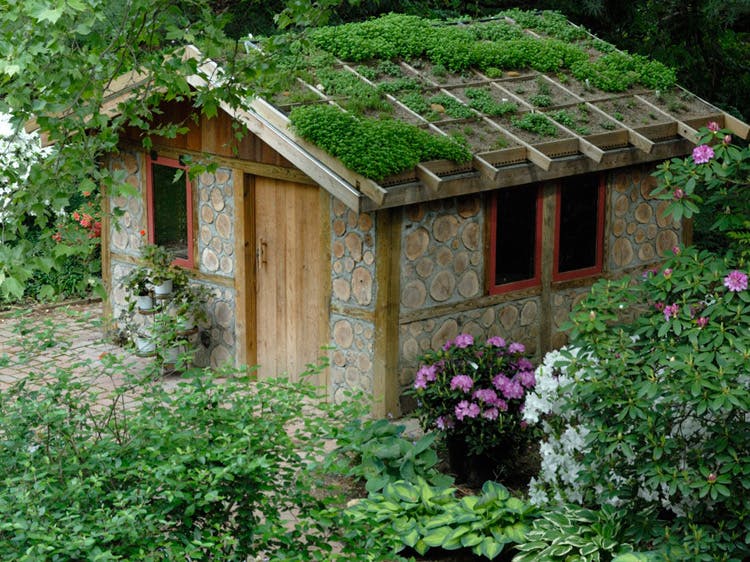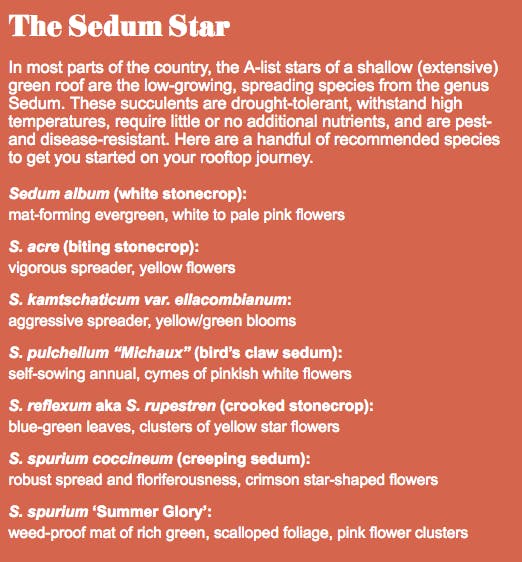As little as ten years ago, the living-roof concept was a mystery to many. Materials, how-tos, and builders were hard to come by. But today, information and resources for small-scale green or living roofs on sheds and studio spaces abound, making it easy and affordable for homeowners to enjoy the benefits of a living roof in their own backyard. Or rather, over their heads.
WHAT ARE THE BENEFITS?
The benefits of green roofs, while not innumerable, are many. For starters, they contribute to biodiversity by attracting butterflies, birds, and pollinators. The insulation they provide can reduce energy costs—a fact that will save significantly on heating and cooling this extra space.
While they are saving energy, the plants also are cleaning the air as they gather and absorb carbon dioxide, work their chemical magic, and release it back into the air as oxygen. Meanwhile, the plant roots are filtering air pollution particles and sponging up rainwater. Thus, they perform storm water management, reducing the demand on sewer systems. All that water the plants absorb also creates a natural fire-resistant layer on the roof, a boon for areas prone to wildfires.
In highly paved urban and suburban areas, living roofs reduce the heat-island effect caused by hard surfaces such as roofs and pavements that absorb heat and reradiate it. The surface of a planted rooftop can be cooler than the air temperature, while the surface of a traditional rooftop may be as much as 80 degrees F hotter.
Finally, while more expensive up front to build than a traditional hard-surface roof, a green roof will last longer because the materials that sun and weather degrade are underground. A traditional roof will last about twenty years, but a green roof is expected to last two to three times longer.
WHAT ARE THE OPTIONS?
If you’re convinced it’s time to replace your roof, you have two types of living roofs to choose from: extensive systems and intensive. Extensive systems typically have a six-inch deep growing medium that can support a range of shallow-rooted plants such as sedum, chives, and meadow grasses. This is the type that most homeowners would choose for a garden structure or the roof of their house. The installation and maintenance costs are relatively low, and the prices are dropping as more people are building them.
Intensive green roofs are deeper and can sustain a complex landscape of small trees, shrubs, ponds, and fountains. These roofs can be either modular, where the vegetation and planting medium are contained in special trays covering all or most of the roof, or nonmodular where, the planting medium is a continuous layer over the entire space.
HOW DO YOU BUILD ONE?
There are books and manuals on the market with detailed instructions for building a living roof. Briefly, the roof is built with a series of layers that insures the system performs properly. The layers will vary slightly depending on the builder but are typically similar.
Start with the roof platform. Be sure the structure can support the added weight, including the roof structure itself. Next is the roofing membrane seal. A seamless pond liner made of heavy-duty EPDM (ethylene propylene diene monomer rubber) works well. Then, the root barrier membrane keeps the underneath layers from being penetrated by roots. The insulation barrier is required by most building codes, even though insulation is provided by plants. Add a water retention mat to reduce the effects of drought cycles. Water drainage and aeration comes next, which helps water flow off the building. The filter allows water to flow without washing away the planting medium. Then, add ultralight-weight planting medium. Generally, this is a synthetically produced expanded clay that is less dense and more absorbent than natural minerals. Finally, plant the plants; ground covers thrive in shallow soils with little to no maintenance.
Article by Home By Design magazine.
Click here for the article.




